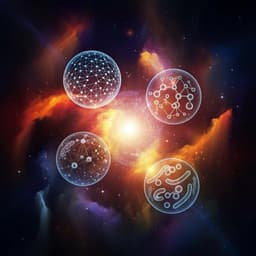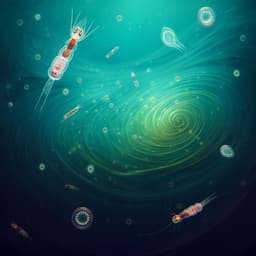
Environmental Studies and Forestry
Climate change is associated with higher phytoplankton biomass and longer blooms in the West Antarctic Peninsula
A. Ferreira, C. R. B. Mendes, et al.
Discover how 25 years of satellite data reveal significant changes in phytoplankton biomass and bloom phenology in the West Antarctic Peninsula, linked to climate change. This research by Afonso Ferreira, Carlos R. B. Mendes, Raul R. Costa, Vanda Brotas, Virginia M. Tavano, Catarina V. Guerreiro, Eduardo R. Secchi, and Ana C. Brito uncovers potential implications for global carbon sequestration and Antarctic food webs.
~3 min • Beginner • English
Introduction
Marine ecosystems along the West Antarctic Peninsula (WAP) have experienced rapid warming, glacier and ice shelf retreat, and declines in sea ice extent, thickness, and volume since the mid-20th century. Primary producers have shown shifts in biomass, composition, and size structure, with spatial contrasts between northern and southern-mid WAP. However, sustained in-situ observations are sparse outside summer, and global satellite algorithms have historically underestimated chlorophyll-a (Chl-a) in this region. This study aims to quantify multi-decadal changes (1998–2022) in phytoplankton biomass and bloom phenology across the Antarctic Peninsula, identify the environmental drivers (notably sea ice decline and large-scale climate modes such as the Southern Annular Mode, SAM), and assess regional differences in response to anthropogenic climate change.
Literature Review
Previous work documented rapid climate change west of the Antarctic Peninsula and ecosystem impacts across trophic levels. Studies report increasing phytoplankton biomass and cell size south of Anvers Island (mid/southern WAP), but decreases in the northern Peninsula, albeit with fewer observations. Satellite ocean colour has been vital for resolving patterns but is challenged by clouds, sea ice, low solar angles, and algorithm biases that underestimate Chl-a in the Antarctic Peninsula by up to a factor of 2. Earlier analyses (e.g., 1997–2010) linked increased primary production to earlier sea ice retreat in spring, while more recent work indicated autumn biomass increases and shifts in bloom timing in ice-influenced regions. Positive SAM phases correlate with warmer surface waters, reduced sea ice, deeper mixed layers, and enhanced intrusions of Circumpolar Deep Water (CDW), all potentially modulating phytoplankton. Community shifts from large diatoms to smaller cryptophytes have been observed in some coastal WAP areas during summers influenced by glacier meltwater, with implications for krill and carbon export.
Methodology
The study used multi-sensor satellite data and in-situ observations for 1998–2022. Satellite ocean colour: ESA OC-CCI v6.0 daily remote sensing reflectance at 4 km resolution was converted to chlorophyll-a (Chl-a, mg m−3) using the OC4-SO regional algorithm calibrated for the Antarctic Peninsula. Environmental data: Daily sea surface temperature and sea ice concentration (OSTIA), and photosynthetically active radiation (GlobColour PAR). Sea ice extent metrics (advance, retreat, duration) were computed per region using a 15% concentration threshold and 5-day persistence. Climate index: Monthly Southern Annular Mode (SAM) index from NOAA CPC. In-situ Chl-a: 4322 surface HPLC-derived measurements (1998–2020) compiled from Valente et al., Palmer LTER, and new Brazilian GOAL-FURG datasets (12 austral summer cruises). GOAL-FURG samples followed standardized filtration, extraction, HPLC analysis, calibration with DHI standards, QA/QC, and internal standard normalization. Regionalization: Agglomerative hierarchical clustering (Manhattan distance, average linkage) of per-pixel seasonal metrics (first growth month post-winter, last growth month post-summer, peak month, and integrated summer Chl-a) identified five coherent subregions: DRA, BRS, WEDN, GES, WEDs. Pixels with year-round sea ice (>15%) were excluded, noise pixels removed, and final maps aggregated to 4 km. Bloom phenology: For each cluster, daily Chl-a was aggregated to 8-day weeks, and the main spring–summer bloom was defined as any event ≥2 weeks where Chl-a exceeds 5% of the annual median. Metrics computed: initiation week, termination week, peak week, duration (weeks), and bloom magnitude (mg m−3 year−1). Trend analyses: For each cluster, monthly mean Chl-a (Sep–Apr), seasonal means, and Sep–Apr means were computed per year. Linear trends (slopes) were estimated using linear regression after removing outliers (>±3 SD). Pixel-wise linear regressions mapped Sep–Apr Chl-a trends and SAM–Chl-a relationships. Due to limited observations, eastern sector regions (WEDi, WEDo) were excluded from trend tests. In-situ trend comparisons used Sep–Apr means for BRS and GES. Decadal comparisons (2001–2010 vs 2011–2020) quantified seasonal contributions to total Chl-a. All analyses were implemented in Python (SciPy, scikit-learn).
Key Findings
- Regionalization identified five subregions (DRA, BRS, WEDN, GES, WEDs) with distinct seasonal Chl-a dynamics. Blooms generally initiate in late Oct–Nov, peak Dec–Feb, and end Mar–Apr, with later, higher peaks in coastal areas.
- Significant increases in mean Sep–Apr phytoplankton biomass (1998–2022) occurred across the WAP, strongest in the Bransfield Strait (BRS) (p<0.05 pixel-wise). Eastern sector changes were unclear due to sparse satellite data.
- Seasonal/Monthly trends highlight shoulder-season increases:
• Early spring (September): DRA +0.003 mg m−3 yr−1 (significant), BRS +0.009 mg m−3 yr−1 (highly significant).
• Early autumn (March–April): larger increases—DRA March +0.008 (**) and April +0.009 (***); BRS March +0.029 (***) and April +0.022 (***); GES March +0.061 (***) and April +0.008 (*). Overall autumn: DRA +0.008 (**), BRS +0.011 (***), GES +0.058 (***), WEDs +0.189 (*).
• Summer trends were weaker regionally, though in-situ data suggest increases: BRS +0.06 mg m−3 yr−1 and GES +0.18 mg m−3 yr−1 (Sep–Apr in-situ trends: BRS Pearson R=0.58, p=0.0043; GES R=0.64, p=0.0026).
- Bloom phenology (1998–2022) changed toward longer blooms, mainly via later terminations:
• DRA: termination +0.416 weeks yr−1 (***), duration +0.419 weeks yr−1 (***).
• GES: termination +0.098 (**) and duration +0.089 (*). Initiation and peak trends were small/not significant in most regions.
- Seasonal contribution shifts (WAP; 2001–2010 → 2011–2020): Autumn share increased from 29% to 42%, summer decreased 53%→44%, spring decreased 18%→14%.
- Sea ice decline is the principal driver enabling earlier spring and enhanced autumn growth; mean sea ice extent decreased in spring and autumn, with later advance/earlier retreat affecting light and stratification windows.
- SAM intensification since ~2010 correlates positively with Chl-a in the southern Drake Passage and northern WAP (pixel-wise SAM–Chl-a correlation significant Sep–Apr), likely via stronger westerlies, deeper mixed layers, enhanced Fe resupply, and increased CDW intrusions. No positive SAM–Chl-a correlation was found in southern coastal WAP (GES).
- Ecological implications include potential shifts from diatoms to cryptophytes in some coastal areas under meltwater influence, with ramifications for krill feeding, food webs, and carbon sequestration.
Discussion
The analysis demonstrates that anthropogenic climate change, expressed through long-term sea ice decline and recent intensification of the Southern Annular Mode, is reshaping phytoplankton biomass and bloom phenology in the WAP. The strongest biomass increases occur in the shoulder seasons (early spring and particularly early autumn), extending bloom duration primarily through later terminations. Reduced sea ice coverage expands the temporal window of favorable light and stratification, enabling growth outside the traditional summer peak. Concurrently, positive SAM phases strengthen westerlies, deepen mixed layers, and enhance vertical nutrient (notably iron) resupply and intrusions of warm, nutrient-rich Circumpolar Deep Water, particularly benefiting offshore and northern WAP regions (DRA, northern BRS). While summer regional satellite trends are less clear, in-situ records indicate summer biomass increases in BRS and GES, suggesting satellites may under-capture some coastal summer variability. Potential shifts toward smaller cryptophytes in meltwater-influenced coastal zones could alter grazing pressure by krill and affect regional carbon export efficiency. Overall, the results link observed biomass and phenology changes to coupled cryospheric–atmospheric–oceanic forcing and highlight significant regional heterogeneity in responses.
Conclusion
This work provides 25-year, regionally calibrated satellite evidence that WAP phytoplankton biomass has increased, especially in early autumn, and that blooms are lasting longer due to later terminations. Long-term sea ice decline is the dominant driver, with recent SAM intensification modulating regional variability and enhancing offshore/northern responses. These changes may have cascading impacts on carbon uptake and Antarctic food webs, including krill-dependent predators. Future research should prioritize high-resolution, year-round in-situ observations (especially spring and autumn), leverage autonomous platforms (floats, gliders), better resolve the interplay of SAM and ENSO on interannual variability, and assess how community shifts (e.g., diatoms to cryptophytes) affect trophic dynamics and carbon sequestration.
Limitations
- Satellite observations in the Antarctic Peninsula are limited by persistent cloud cover, sea ice adjacency, low solar angles, and historically biased global Chl-a algorithms; despite using the regional OC4-SO algorithm, uncertainties remain, particularly in coastal and ice-adjacent pixels.
- The eastern Antarctic Peninsula sector has sparse valid satellite data, reducing confidence in detected trends there; some regions (WEDi, WEDo) were excluded from trend analyses.
- Bloom phenology estimates can be sensitive to data gaps and threshold choices; limited non-summer in-situ sampling constrains validation, and most in-situ data are summer-biased.
- Linear trend analyses over 25 years may miss non-linearities or regime shifts; regional physical complexity (e.g., BRS eddies/fronts) introduces high variability that can obscure trends.
- Inferences on nutrient dynamics (e.g., iron resupply) and community composition shifts are indirect, based on correlations and prior studies; direct seasonal biogeochemical measurements are limited.
Related Publications
Explore these studies to deepen your understanding of the subject.







